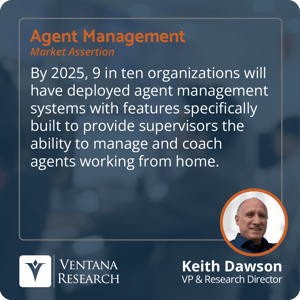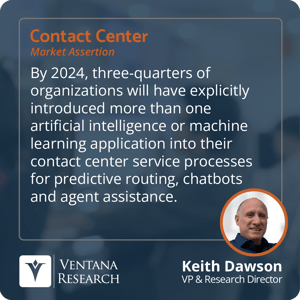The contact center industry is reexamining how organizations engage with contact center agents. One thing that we learned from the forced movement to work-from-home was that organizations have to provide agents with appropriate tools to collaborate and communicate with peers and supervisors as well as workers in the back office who participate in all sorts of customer-facing or customer-adjacent processes. It is also important to provide supervisors with visibility into agent activity. That means extending existing coaching and evaluation methods. Ventana Research believes that by 2025, nearly every organization will have dedicated systems or processes that help supervisors manage remotely.
 Another shift is more subtle: The kinds of skills centers need to find and develop are changing. As consumers move to digital interactions and enhanced self-service, the problems that reach the agent are more complex and time-consuming. That forces a pivot in training emphasis to soft skills, helping agents act as gatekeepers, problem solvers and customer advocates. That means they need training for empathy and problem-solving, and in identifying moments of influence, spotting revenue generating sales opportunities and taking advantage of them.
Another shift is more subtle: The kinds of skills centers need to find and develop are changing. As consumers move to digital interactions and enhanced self-service, the problems that reach the agent are more complex and time-consuming. That forces a pivot in training emphasis to soft skills, helping agents act as gatekeepers, problem solvers and customer advocates. That means they need training for empathy and problem-solving, and in identifying moments of influence, spotting revenue generating sales opportunities and taking advantage of them.
Some of the tools coming into view include things like real-time agent guidance or agent assist, often powered by artificial intelligence, that helps them handle those more complex interactions, and experiences with omnichannel components that blend channels. We’re also seeing a lot of organizations exploring how to implement automation – and how much of it – because the idea that you can automate everything and reduce the need for agents just isn’t practical. Humans are going to be in the loop for quite some time. We’re also seeing the need to bring more people into the customer-service mix – especially knowledge workers behind the scenes in the back office who often have the specific domain expertise needed to address particular customer issues.
Anecdotal evidence suggests that as much as half of interaction volume can be diverted from agents, and that’s quite a bit better than the old rule of thumb that about 30% could be deflected by basic interactive voice response. But deflection doesn’t mean the call magically goes away and is cost-free. Deflection to automation creates the environment for more constructive conversations with agents when customers reach the point where automation’s capabilities are exhausted. And those more constructive conversations can be difficult at times, potentially expensive, but also potentially revenue-generating if you read the situation correctly and position assets to respond positively.
There are three powerful strategies organizations can use to mitigate some of the problem. Automation is critical, including internal automation of workflows and tools for agent assistance that automatically surface relevant materials, offers or suggested courses of action for agents.
Second, burden-sharing, which means using agents as a gateway to the entire customer journey that brings in back-office knowledge workers, marketing and sales teams as well as other experts who have reason to touch the customer.
And third, skill-sharpening through training. This signals to staff that they are the organization’s version of essential workers, worthy of investment and vital to the health of the customer relationship.
There are several layers of important technology that come into play in current workforce engagement to create a happier and more satisfying agent experience. First, the obvious: Nothing is going to improve if there isn’t a communication and collaboration infrastructure available to let agents talk to their peers, ask for help, talk about best practices, gossip and get to know each other, even though they may be physically far apart. And that infrastructure has to also take into account the different kinds of security and privacy issues that arise when agents are offsite. Is someone’s home Wi-Fi secure enough? Is it ok to have personal customer information discussed with family members floating in and out of the room?
On a deeper level, centers should take advantage of the newest developments in knowledge support. One thing we’ve seen in the emergence of AI in contact centers has been how it supports new types of knowledge management that uses a wider variety of information sources to gather solutions and then assesses it to provide agents with suggestions and guidance in the form of next-best actions or insight about the context of a customer interaction.
And then there is the wealth of automation that the customer directly touches – for example, virtual assistants that can either solve issues outright (causing deflection) or prep the customer with accurate, consistent information that matches the information the agent has, reducing disconnects and annoyances.
 Another prediction we’ve made is that by 2024, three quarters of organizations will deploy AI in some form in centers. The use cases we’re seeing seem to be very focused around improving the way agents do their work. Some of it is on the management side, providing easier ways for agents to self-manage their shifts and work periods, or in having evaluations go fully automated.
Another prediction we’ve made is that by 2024, three quarters of organizations will deploy AI in some form in centers. The use cases we’re seeing seem to be very focused around improving the way agents do their work. Some of it is on the management side, providing easier ways for agents to self-manage their shifts and work periods, or in having evaluations go fully automated.
Automation is becoming like water or electricity – part of the background services that are essential but not really noticed until you’re looking for them. And automation is everywhere. The self-service angle has been well explored, with conversational systems and bots very common and increasingly accepted as self-service vehicles for consumers.
From the worker’s point of view, automation is becoming embedded into standard processes, so there is a human in the loop when needed, or absent when not needed. Automation is also useful in subtly making more and better data flow through the contact center into other parts of the organization, especially connecting the center to the back office, again letting the agent act as the orchestrator of whatever processes the customer needs.
Automation helps an organization create an employee experience that’s uniform, fair and knowable. It enables things like gamification, makes training easier to implement and helps workers view processes as fair and even-handed. Certain aspects of the job – like access to information, skills, rewards or career opportunities – are available to everyone based on known and unbiased criteria. That’s important in attracting and keeping talent. It’s also something that managers should communicate to agents more effectively.
Clearly, the industry is headed for an extended period of change and uncertainty. There are three ways the current situation can play out. The first option is that everything goes back to some semblance of pre-2019 normal, where most agents are in centers, work-from-home is an option for the most talented or valuable agents you need to keep and operations snaps back to what most managers were used to pre-pandemic.
On the other hand, the most extreme scenario is that nothing goes back to the old way: Agents are primarily working remotely, and organizations become adept at managing in that environment.
Where we will actually land sometime in the next two years or so is in the middle, with a hybrid environment in which both modes of work are possible, and work-from-home is prevalent enough to require organizations to build structures that make it work cost-effectively. When we think about the agent experience in that environment, including hiring and retention, we’re looking at having to spend more managerial time finding ways to bring agents together, virtually and physically. The new normal is going to look a lot more diverse and varied, with lots of ways for organizations to experiment, which will lead to some creative workforce engagement practices and differentiations.
We end up with a workforce that’s more distributed, but also better equipped and more flexible in terms of the kinds of issues they can deal with and the impact they have on the customer’s view of the organization.
In some ways agents become more important individually, meaning they become more expensive individually because you’re paying for better skills and the training to keep them. We’re not likely to see a significant reduction in the size of the contact center workforce any time soon. That suggests that the best way to maintain a solid staff of well-skilled agents is to invest in the things that make people valuable and attached to an organization: better skills, a fair, communicative relationship with supervisors and managers and flexibility to accommodate their technology needs wherever they may be sitting.
Regards,
Keith Dawson


 Another shift is more subtle: The kinds of skills centers need to find and develop are changing. As consumers move to digital interactions and enhanced self-service, the problems that reach the agent are more complex and time-consuming. That forces a pivot in training emphasis to soft skills, helping agents act as gatekeepers, problem solvers and customer advocates. That means they need training for empathy and problem-solving, and in identifying moments of influence, spotting revenue generating sales opportunities and taking advantage of them.
Another shift is more subtle: The kinds of skills centers need to find and develop are changing. As consumers move to digital interactions and enhanced self-service, the problems that reach the agent are more complex and time-consuming. That forces a pivot in training emphasis to soft skills, helping agents act as gatekeepers, problem solvers and customer advocates. That means they need training for empathy and problem-solving, and in identifying moments of influence, spotting revenue generating sales opportunities and taking advantage of them. Another prediction we’ve made is that by 2024, three quarters of organizations will deploy AI in some form in centers. The use cases we’re seeing seem to be very focused around improving the way agents do their work. Some of it is on the management side, providing easier ways for agents to self-manage their shifts and work periods, or in having evaluations go fully automated.
Another prediction we’ve made is that by 2024, three quarters of organizations will deploy AI in some form in centers. The use cases we’re seeing seem to be very focused around improving the way agents do their work. Some of it is on the management side, providing easier ways for agents to self-manage their shifts and work periods, or in having evaluations go fully automated.








